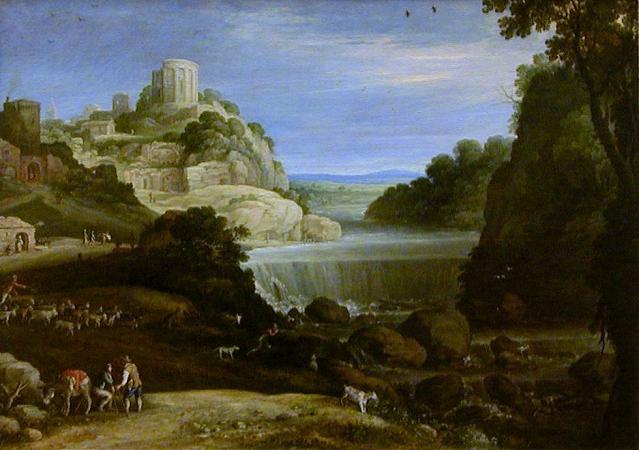Landscape with Waterfall. A waterfall is an area where water flows over a vertical drop or a series of steep drops in the course of a stream or river. Waterfalls also occur where meltwater drops over the edge of a tabular iceberg or ice shelf. Waterfalls are commonly formed in the upper course of a river in steep mountains. Because of their landscape position, many waterfalls occur over bedrock fed by little contributing area, so may be ephemeral and flow only during rainstorms or significant snowmelt. The further downstream, the more perennial a waterfall can be. Waterfalls can have a wide range of widths and depths. When the river courses over resistant bedrock, erosion happens slowly and is dominated by impacts of water-borne sediment on the rock, while downstream the erosion occurs more rapidly. As the watercourse increases its velocity at the edge of the waterfall, it may pluck material from the riverbed, if the bed is fractured or otherwise more erodible. Hydraulic jets and hydraulic jumps at the toe of a falls can generate large forces to erode the bed, especially when forces are amplified by water-borne sediment. Horseshoe-shaped falls focus the erosion to a central point, also enhancing riverbed change below a waterfalls. A process known as potholing involves local erosion of a potentially deep hole in bedrock due to turbulent whirlpools spinning stones around on the bed, drilling it out. Sand and stones carried by the watercourse therefore increase erosion capacity. This causes the waterfall to carve deeper into the bed and to recede upstream. Often over time, the waterfall will recede back to form a canyon or gorge downstream as it recedes upstream, and it will carve deeper into the ridge above it. The rate of retreat for a waterfall can be as high as one-and-a-half metres per year. Often, the rock stratum just below the more resistant shelf will be of a softer type, meaning that undercutting due to splashback will occur here to form a shallow cave-like formation known as a rock shelter under and behind the waterfall. Eventually, the outcropping, more resistant cap rock will collapse under pressure to add blocks of rock to the base of the waterfall. These blocks of rock are then broken down into smaller boulders by attrition as they collide with each other, and they also erode the base of the waterfall by abrasion, creating a deep plunge pool in the gorge downstream. Streams can become wider and shallower just above waterfalls due to flowing over the rock shelf, and there is usually a deep area just below the waterfall because of the kinetic energy of the water hitting the bottom. However, a study of waterfalls systematics reported that waterfalls can be wider or narrower above or below a falls, so almost anything is possible given the right geological and hydrological setting. Waterfalls normally form in a rocky area due to erosion. After a long period of being fully formed, the water falling off the ledge will retreat, causing a horizontal pit parallel to the waterfall wall. Eventually, as the pit grows deeper, the waterfall collapses to be replaced by a steeply sloping stretch of river bed. In addition to gradual processes such as erosion, earth movement caused by earthquakes or landslides or volcanoes can cause a differential in land heights which interfere with the natural course of a water flow, and result in waterfalls. A river sometimes flows over a large step in the rocks that may have been formed by a fault line. Waterfalls can occur along the edge of a glacial trough, where a stream or river flowing into a glacier continues to flow into a valley after the glacier has receded or melted. The large waterfalls in Yosemite Valley are examples of this phenomenon, which is referred to as a hanging valley. Another reason hanging valleys may form is where two rivers join and one is flowing faster than the other. Waterfalls can be grouped into ten broad classes based on the average volume of water present on the fall using a logarithmic scale. Class 10 waterfalls include Niagara Falls, Paulo Afonso Falls and Khone Falls. Classes of other well-known waterfalls include Victoria Falls and Kaieteur Falls; Rhine Falls and Gullfoss; Angel Falls and Dettifoss; Yosemite Falls, Lower Yellowstone Falls, and Umphang Thee Lor Sue Waterfall; and Sutherland Falls. Alexander von Humboldt Father of Modern Geography Humboldt was mostly marking waterfalls on maps for river navigation purposes. Oscar von Engeln Published Geomorphology: systematic and regional, this book had a whole chapter devoted to waterfalls, and is one of the earliest examples of published works on waterfalls. R. W. Young Wrote Waterfalls: form and process this work made waterfalls a much more serious topic for research for modern Geoscientists.
more...














